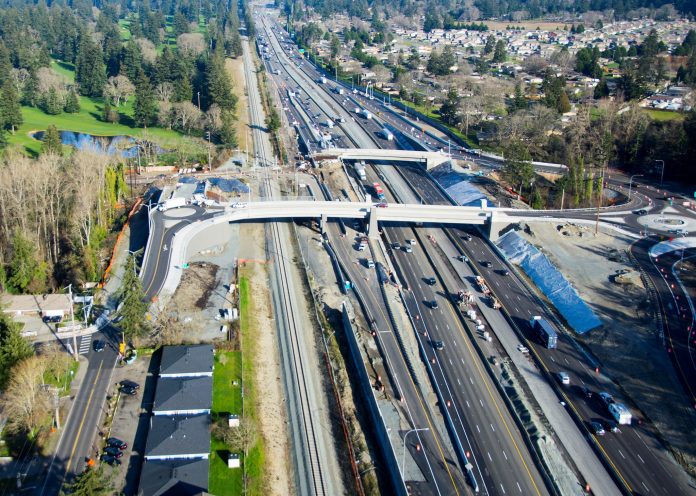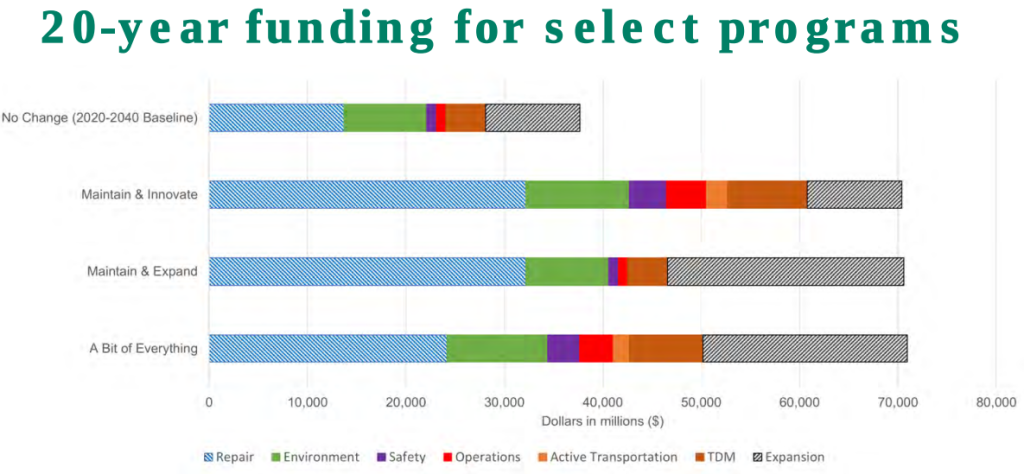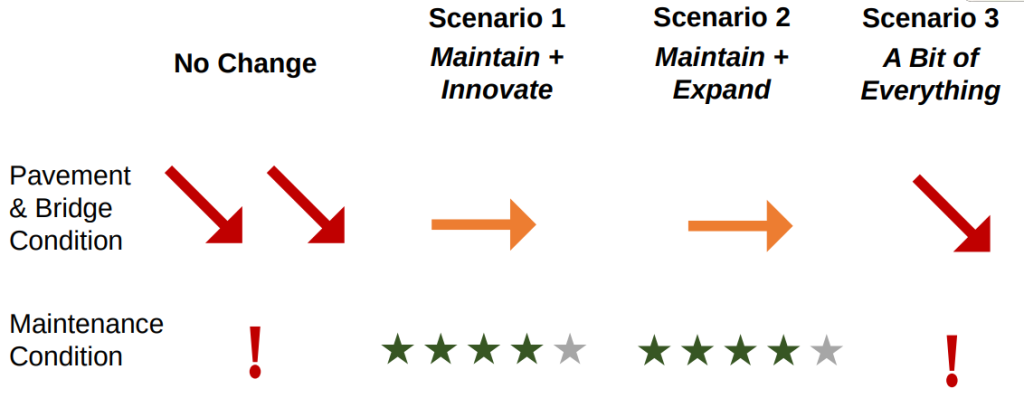
The Washington State Department of Transportation (WSDOT) is in the process of updating its Highway System Plan right now. Refreshed every decade or so, the HSP lays out the agency’s broad priorities for how to maintain and improve the state highway network, and what’s in the plan has direct implications on what WSDOT will submit in its budget request to the governor and the state legislature. However, despite formal recognition by state government of the need to reduce greenhouse gas emissions, the current HSP update appears to lack substantive analysis of its climate impacts.
In April, The Urbanist covered how the agency is gathering feedback on the plan though a flawed survey that allows users to pick and choose how they’d prioritize money in the highway budget, but which doesn’t allow them to spend less than $800 million per year on new and expanded highway infrastructure.
Now the agency is moving forward three scenarios for additional analysis as it prepares to finalize the plan later this year.
One is a “maintain and innovate” scenario that increases spending on maintenance for current highways and assumes that new and expanded highways would only be funded at the level they’re receiving now. In that scenario, the agency would spend more funds than it has in the past on active transportation, transportation demand management, and improvements in safety.
A second scenario, the “maintain and expand” one, just spends additional money on both maintenance and expanded highways.
A third scenario, dubbed “a bit of everything,” tries to add some additional funding to all of the possible categories, including safety, active transportation, maintenance, and expansion. None of the three scenarios being looked at includes spending fewer than $10 billion on new and expanded highways over the next two decades, despite transportation being the single largest source of greenhouse gas emissions in Washington.

In May, WSDOT presented to the Washington Transportation Commission on its analysis of the three scenarios, showing how it had concluded each scenario performed on a number of different metrics. The “bit of everything” proposal scored the worst on almost all of them, including keeping up with maintenance.

But when it comes to analyzing the environmental impact of these scenarios, things come off the rails. WSDOT told the commission that its initial analysis concluded the three scenarios had essentially the same impact on the state’s greenhouse gas emissions. In other words, according to WSDOT, spending $10 billion on expanded highways (in the “maintain and innovate” scenario) would have exactly the same impact as spending more than double that (in the “maintain and expand” one).

This startling fact was noticed by Hester Serebrin, a transportation commissioner and policy director at Transportation Choices Coalition, who asked how “a major investment in expansion gets a green check in terms of GHG given what we know about induced demand,” the now well-established fact that adding additional roadway capacity in places where it’s in high demand will lead to more driving.
“I don’t think there’s a high degree of confidence in this answer right now, but just from [the modeling group’s] preliminary sensitity testing, they’re not seeing a big difference… for right now, that’s the best information they could give us,” Karena Houser, a statewide planning manager at WSDOT, responded. “There’s other things that are driving GHG emissions more than the way we spend the money, on the infrastructure choices that we had in our scenario,” she said.
The Urbanist followed up via email with WSDOT acting communications director Emily Glad, who reiterated that further analysis of greenhouse gas emission impacts is planned. But she broadly defended the idea that project level emissions have little impact.
“WSDOT policy does require addressing greenhouse gas emissions and climate change at the project level,” Glad wrote. “WSDOT believes GHG emissions are an issue of global concern. In our work to date, we have found that greenhouse gas emissions from a single project action are usually very small (and often less than without the project). In general, project-level actions that can help reduce greenhouse gas emissions include: expanding transit and non-motorized options for travelers, improving intersection traffic flow to reduce idling, creating more safe and efficient freight movement, and increasing vegetation density over pre-project conditions to sequester carbon.”
Here Glad pulls out an often-used argument in favor of expanding roadways: that additional lanes will decrease the number of idling vehicles and therefore decrease emissions. Data does show that stop and go traffic, as well vehicles traveling at speeds below 40 miles per hour or above 60 miles per results in higher emissions per mile traveled. However, when it comes to emissions, the amount of vehicle miles traveled (VMT) and fuel efficiency of the vehicle have a more significant impact than speed.
In fact, a 2012 study conducted by researchers at Portland State University concluded there was no correlation between levels of congestion in a metropolitan area and per-capita greenhouse emissions, while the amount of VMT in a region was strongly correlated with emissions.
“Capacity expansions that reduce marginal emissions rates by increasing travel speeds are likely to increase total emissions in the long run through induced demand,” Alex Bigazzi and Miguel Figliozzi, the paper’s authors, concluded. The Urbanist included the myth expanding roadways to decrease greenhouse gas emissions in our list of five huge mistruths that are delaying climate action.
However, WSDOT also told the transportation commission that it had concluded the scenarios are exactly the same in terms of the quantity of VMT per person, another fact that illustrates the lack of rigorous analysis being conducted around the plan.

In late 2021, WSDOT released an early report on how the state could set targets for reducing VMT and set localities up to meet those targets. WSDOT’s own report undermines the claim that expanded highways would have little impact on VMT. “Potential highway expansion, as opposed to other transportation investments, generally increases vehicle miles of travel by making access to land further away more attractive than it previously was,” the report states. “On the other hand, investing in transportation efficient communities can lower vehicle miles of travel by locating people closer to the activities they wish to engage in and providing them with transportation choices other than driving alone.”
To give Washington residents a better idea of how their tax dollars could be invested in transportation, the HSP update should clearly provide an alternative model that shows what it would mean for the state to invest that additional ten billion dollars in other transportation choices like transit and active transportation, as well as study a no-build alternative that analyzes spending zero additional dollars on expanding highways. These models should be accompanied by a more rigorous analysis of all the models’ greenhouse gas emissions. Such an approach would provide greater honesty and transparency around emissions impacts.
As states like Colorado move toward quantifying and curtailing project-level emissions from highway expansions, to see this insufficient level of analysis from WSDOT around a plan that will guide investments over the next 20 years is extremely disappointing. It’s long past time for WSDOT to stop burying its head in the sand and conduct an honest analysis of the climate impacts of continuing to expand the state highway network.
Ryan Packer has been writing for The Urbanist since 2015, and currently reports full-time as Contributing Editor. Their beats are transportation, land use, public space, traffic safety, and obscure community meetings. Packer has also reported for other regional outlets including Capitol Hill Seattle, BikePortland, Seattle Met, and PubliCola. They live in the Capitol Hill neighborhood of Seattle.


